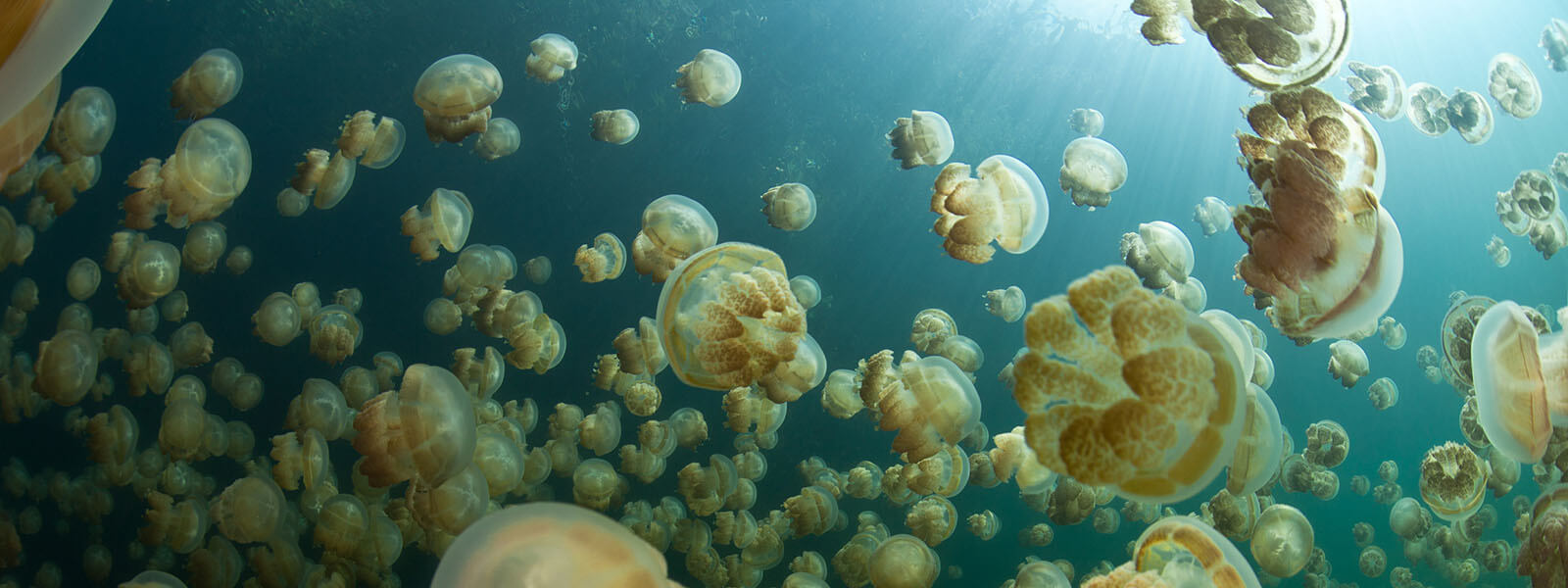Snorkeling Palau’s Underwater Wilderness
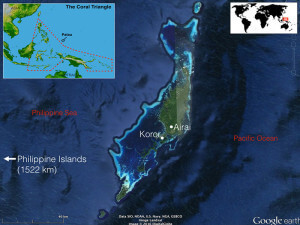 The Republic of Palau is a cluster of volcanic and limestone islands enclosed by a barrier reef, located along the western perimeter of the Caroline Islands in Micronesia. The origin of Palau is a classic example of an island archipelago born of fire. As the Pacific Plate submerged under the Philippine Plate (a process called subduction), magma was released and rose to the surface where it cooled to form an island (in this case, the main island of Babeldaob).
The Republic of Palau is a cluster of volcanic and limestone islands enclosed by a barrier reef, located along the western perimeter of the Caroline Islands in Micronesia. The origin of Palau is a classic example of an island archipelago born of fire. As the Pacific Plate submerged under the Philippine Plate (a process called subduction), magma was released and rose to the surface where it cooled to form an island (in this case, the main island of Babeldaob).x
Ancient limestone reefs flourished in the shallow water around Babeldaob, and a barrier reef developed as the Philippine Plate sank back into Earth’s mantle. After millions of years of growth, the once vibrant shallow reefs become exposed to the air due to a series of interactions between the plates caused their uplift. Now exposed to air, rain, wind, and to a lesser degree, vegetation the relatively soft limestone ‘slabs’ erode to create valleys, gullies, sinkholes, and island-pinnacles.
x
During the glacier periods of the Pleistocene, sea water levels around the western Pacific were hundreds of feet lower than present day levels. As a result, more limestone was now exposed to the erosive power of freshwater and wind. When the glaciers melted and sea levels rose, the lagoon was once again submerged with seawater filling in the eroded valleys and sinkholes and stranding pinnacles to create the present-day maze of islands, passes, bays, and marine lakes.
x
Located 7º north of the equator and bathed in warm, tropical seas, Palau is a must for all snorkelers. Within the barrier reef that surrounds the southern lagoon are hundreds of square kilometers of reef habitat that includes shallow patch reefs, reef flats, Acropora thickets, coral gardens, sheltered reefs, exposed reefs, and steep walls. Recent surveys found that the reefs of Palau support over 1500 species of marine fishes and with 486 species of reef building corals they earned honorable mention for inclusion into the Coral Triangle, A geographic term that describes the region that possess the world’s highest levels of marine biodiversity.
x
Hundreds of mushroom-shaped limestone islands topped by a thick layer of vegetation that show greens in a variety of hues, create a magnificent backdrop to the private bays, quiet lagoons, wonderful marine lakes, and intimate passages that exist within the network of islands. It is not hard to imagine why the Rock Islands are considered to be one of the most stunning marine seascapes, and one of the best snorkeling destinations on the planet.
x
Our extended, entirely boat-based snorkeling tour revolves around many of these amazing marine habitats. From the steep outer reefs around the southern end of the Rock Islands where thousands of reef fish dance in the currents to the private marine lakes of Nikko Bay where shallow coral gardens host a variety of juvenile reef fish. Palau is truly a snorkeler’s dream.
ITINERARY
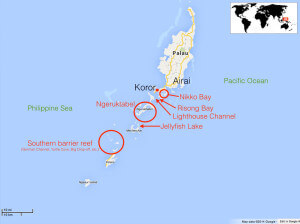 Our special 17-day snorkeling tour begins and ends in Koror, Palau. No internal flights. We begin the tour with a night at Palau Pacific Resort and transfer to the boat the next day. This new approach to our itinerary (in the past, 7-nights on the boat and 6-nights at Palau Pacific Resort) is based on our desire to spend more time in the southern part of the barrier reef (particularly Peleliu), more time at Ulong (two days), and have the convenience of the boat throughout our time in Palau. Please note that the following is a general itinerary and that weather, tides, and other unforeseen or unavoidable circumstances may affect the schedule at any time.
Our special 17-day snorkeling tour begins and ends in Koror, Palau. No internal flights. We begin the tour with a night at Palau Pacific Resort and transfer to the boat the next day. This new approach to our itinerary (in the past, 7-nights on the boat and 6-nights at Palau Pacific Resort) is based on our desire to spend more time in the southern part of the barrier reef (particularly Peleliu), more time at Ulong (two days), and have the convenience of the boat throughout our time in Palau. Please note that the following is a general itinerary and that weather, tides, and other unforeseen or unavoidable circumstances may affect the schedule at any time.
Day 1: Koror, Palau
Meals provided:
Airport arrival and transfer to Palau Pacific Resort. Overnight Palau Pacific Resort.
Days 2 : Palau Pacific Resort / Rock Island Aggressor
Meals provided: B,L,D
After breakfast we will have our first chance to immerse ourselves in Palau’s warm tropical ocean water! The house reef at PPR is a shallow, sandy habitat abundant with coral and sea grass. We have all day to explore the rich area, where we can look for giant clams, rooftop pipefish, and watch varieties of parrotfishes and wrasses roam through the reef and seagrass beds. There are also aged pilings along the northern edge of the beach that are worth our attention! In the late afternoon, we board the Rock Island Aggressor and begin our journey to the southern end of Palau’s barrier reef. Overnight Rock Island Aggressor.
Day 3: Southern Barrier Reef / Ngedebus Coral Gardens / Turtle Cove
Meals provided: B,L,D
We wake to find ourselves moored just outside the barrier reef in the southern end of the archipelago. Shallow reef flats, abundant with corals and reef fish sit atop nearly a thousand feet of nearly vertical reef. This area gives us the chance to begin our snorkeling in a relatively shallow part of the barrier reef where we will find spur and groove type of reef development. Healthy corals attract a variety of tropical fish including schools of snapper, rabbitfishes, and goatfishes as well as blacktop sharks, turtles, and eagle rays. Turtle Cove is a continuation of Ngedebus, with noticeable differences being a more vertical wall and the chance to snorkel above (or down into!) a natural sink hole in the shallow reef flat. we’ll look for schools of parrotfishes, several different species of butterflyfishes and the fire tail dartfish along the shallow reef margin! Overnight Rock Island Aggressor.
Day 4: Peleliu
Meals provided: B,L,D
The island of Peleliu defines the southern tip of the Palau’s barrier reef, and while famous for the brutal battle fought there in 1944, it is locally famous for having some of the most dynamic reefs in the archipelago. Weather and currents will dictate whether we will snorkel in some of the coral gardens on the east side, or above walls on the west side. If we have time, we will arrange to visit some of the WWII wrecks left behind after the war. Overnight Rock Island Aggressor.
Day 5 – 6: Southern Barrier Reef / Big Drop-off / German Channel
Meals provided: B,L,D
We continue to explore some of Palau’s best reefs in the southern part of the barrier reef. Palau is famous for the variety and abundance of marine life that dwells along the vertical, seaward reefs. Schools of anthias, damselfishes, barracudas, jacks, snappers, and unicornfishes contribute to the thousands of reef fishes that can be found along the reef margins. Expect to see sharks and rays as Palau is one of the few countries in the world that affords them complete protection. Grey reef, blacktip, and whitetip reef sharks are common and with a bit of luck, we may encounter manta rays and spotted eagle rays. Some of our snorkel sites along the barrier reef include Big Drop-off, German Channel, Virgin Blue Hole, and Barnum’s Wall. Overnight Rock Island Aggressor.
Day 7: Jellyfish Lake / Einstein’s Garden
Meals provided: B,L,D
Moored inside Palau’s lagoon, we are surrounded by rock islands that are alive with the sounds of bird and insect calls. Our destination this morning is Jellyfish Lake where millions of golden and thousands of moon jellies can be found floating peacefully in the protected marine lake. This is an out-of-this-world experience as we become almost encapsulated by these beautiful jellies. Thousands of years of isolation and a food supply provided largely by their symbiotic algae\ has rendered their stinging nematocysts impotent. In the afternoon, we will visit Einstein’s Garden where colorful species of brain corals grow in great abundance within the sheltered arms of the Rock Islands. Nearby is another charming marine lake that we can visit via snorkeling and we will have the opportunity for an intimate experience with mud in the Milky Way :-). Overnight Rock Island Aggressor.
Day 8: Lighthouse Channel
Meals provided: B,L,D
Lighthouse channel is named for the large 1900’s-era German-built lighthouse that sits atop the northeastern tip of Urukthapel, overlooking the eastern entrance (Lighthouse channel) into Malarial harbor. During WWII, Japanese soldiers used the trail to the top to set up canons to defend the harbor entrance. We’ll spend the day snorkeling in the intimate network of marine lakes and tiny pocket reefs near the ‘dock’ that allows access to the trail. And for those interested in the hike, not only is it worth it for the view, but for the chance to see Micronesian kingfishers and some neat history in the form of a centuries-old lighthouse and 6” WWII canons strewn upon the trail. Dinner at Kramer’s Bar and Restaurant in Koror. Overnight Rock Island Aggressor.
Day 9 – 10: Ulong Island
Meals provided: B,L,D
Located along the western edge of the barrier reef, the island of Ulong is not only one of the more beautiful of the islands in Palau but is also home to the one of the best snorkel sites in Palau, Ulong channel. Thousands of years of tidal movements created a huge channel in the reef. Schools of snapper, unicornfishes, goatfishes, barracuda, and trevally hover above the substrate where nooks between the dense coral growth harbor giant grouper. Along the shallow sides of the channel are fields of blue, green, and yellow staghorn coral intermixed with huge century-old boulder corals. Ulong Island also has a network of bays and lagoons where we can find shallow protected reefs buzzing with juvenile reef fish. Add in a marine lake, examples of WWII and cultural history, and a beautiful white sand beach perfect for lunch! Overnight Rock Island Aggressor.
Day 11: Rock Islands
Meals provided: B,L,D
Within the Rock Islands of Palau are several snorkel sites that offer unique and rewarding opportunities. First is the rich fringing reef called Cemetery Reef. Named for the overall shape of the reef (headstone-like) it is far from dead. With nearly 80% coral coverage and aquarium like conditions, this reef usually gets a lot of attention from our guests. Soft Coral Arch is a small but mesmerizing snorkel site. Consistent water movement through a shaded arch in the rock island created a ‘perfect storm’ of conditions ideally suited for several species of colorful soft corals, notably a species of Dendronephythea that can be bright purple, pink, orange, or red! Lunch on the boat somewhere in there and then we will visit a shallow shipwreck, completely intact and overgrown with coral. Overnight Rock Island Aggressor.
Day 12 – 13: Nikko Bay / Risong Bay
Meals provided: B,L,D
Nikko Bay is a collection of stunning rock islands that harbor a variety of amazing fringing reefs, shallow coral gardens, marine lakes, classic and collapsed caves, and historical WWII wrecks left behind by the Japanese during their occupation of Palau. Nikko will be a long day for us! Nearby Risong Bay is a large bay fringed by a series of intimate marine lakes including Palau’s famous Mandarinfish Lake! We begin the day with a visit to Blacktip Lake to see the variety of birds that inhabit the rock islands as well as snorkel the reef/seagrass bed out front. Overnight Rock Island Aggressor.
Day 14: Airai Stone Money / Nikko Bay
Meals provided: B,L,D
The stone money that Yapese sailors brought back to the island of Yap was quarried in Palau and there is a well preserved quarry site located in Airai that we can access from a small dock along the shoreline. A short hike takes us to a site where examples of stone money in various stages of completion can be found. The rest of the day will be spent in Nikko Bay, visiting snorkel sites that we missed due to time limitations the day before. Overnight Rock Island Aggressor.
Day 15: Lighthouse Channel
Meals provided: B,L,D
After breakfast we’ll snorkel a reef adjacent to Buoy #6 in Lighthouse Channel. This once famous dive site is still known for the abundance of shallow coral that benefits from strong water movement in and out of the area. But why is it not necessarily famous anymore? The wreck, called Buoy #6, was the attraction and it has since disintegrated in the strong currents and corrosive conditions. In the afternoon we will take a final rock island tour through the gorgeous network of limestone islands and snorkel in one of the many lush coral gardens that grow right up next to the islands. Overnight Rock Island Aggressor.
Day 16: Palau Pacific Resort / PICRC
Meals provided: B,L,D
After breakfast, we will transfer to PPR and check in to our rooms. In the late morning we will visit the aquarium at Palau International Coral Reef Center. After lunch in town, the rest of the afternoon is on your own. Farewell dinner at PPR followed by late evening transfers to the airport. Overnight Palau Pacific Resort*.
*We have the hotel reserved for the entire night. Most international flights routing through Guam (and onwards to the United States) depart Palau around 2:00am. Thus, we will be departing the resort on Day 16 (midnight) to make our international connections on Day 17 (around 2:00am).
Day 17: International flights or extensions
Please make flight reservations to depart Palau on Day 17 (unless you are extending your stay). Most international flights routing through Guam (and onwards to the United States) depart Palau around 2:00am
DEPARTURES
April 06 – 22, 2024←Click to request a booking
Accommodations: Rock Islands Aggressor, Palau Pacific Resort
Guides: Lee Goldman
Length: 17 days
Prices and Payment schedule:
$8500 USD per person, double occupancy
Please enquire about the limited availability of single cabins
Reservation deposit: $500 USD
Oct 06, 2023: $4000 USD
Jan 06, 2024: $4000 USD
Tour cost includes:
- Accommodations on day 1 through day 17
- All meals on days 2 through 16 (dinner on day 1)
- All internal transfers including international arrival and departure transfers
- Non-alcoholic beverages
- All snorkeling and park fees
- All gratuities
Tour cost does not include:
- Round-trip international airfare
- Additional hotel accommodations and meals as a result of travel outside of the program dates
- Visa requirements including payments
- Alcoholic beverages
- International departure taxes
- Extra / overweight baggage fees
- Trip insurance (recommended; (we recommend Travel Guard, World Nomads, or Travel Insure)
- DAN insurance (required unless personal insurance program has worldwide emergency evacuation services)
- Additional accommodations while on tour in the event of flight schedule changes or events of force majeure
- Fuel surcharges (if applicable)
Cancellation policy:
180 – 91 days prior to departure: 50% of trip cost
90 days or less prior to departure: 100% of tour cost
Please see our Terms and Conditions
ACCOMMODATIONS
We use the finest live-aboard boat to host us on our snorkeling adventures in Palau, the Rock Island Aggressor. Our resort is the luxurious Palau Pacific Resort. Please visit our accommodations page for more photos or use the link to visit the given website.
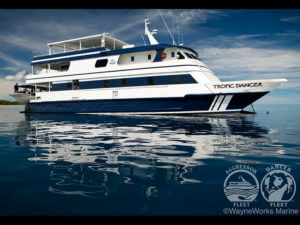 The Rock Island Aggressor, formerly as the Tropic Dancer, is a steel-hull, catamaran that measures 106 feet long with a 30-foot beam. She holds 18 passengers in 9 comfortable, air-conditioned rooms each with their own bathroom facilities. All of the rooms include picture windows, hair dryers, and plenty of storage space. Meals are served in the spacious salon and consist of western and Micronesian dishes. The sun deck has areas for sunbathing and a shaded area to enjoy the outside with sun exposure. She is equipped with state-of-the-art navigation systems and possesses a full complement of safety features. AED (Automatic External Defibrillator), 406 EPIRB (Emergency Position Indicating Radio Beacon), life crafts, jackets, and Fire and smoke detection systems. More photos
The Rock Island Aggressor, formerly as the Tropic Dancer, is a steel-hull, catamaran that measures 106 feet long with a 30-foot beam. She holds 18 passengers in 9 comfortable, air-conditioned rooms each with their own bathroom facilities. All of the rooms include picture windows, hair dryers, and plenty of storage space. Meals are served in the spacious salon and consist of western and Micronesian dishes. The sun deck has areas for sunbathing and a shaded area to enjoy the outside with sun exposure. She is equipped with state-of-the-art navigation systems and possesses a full complement of safety features. AED (Automatic External Defibrillator), 406 EPIRB (Emergency Position Indicating Radio Beacon), life crafts, jackets, and Fire and smoke detection systems. More photos
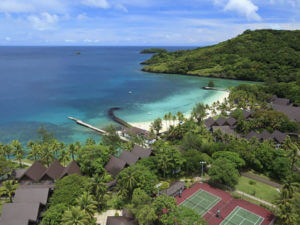 Palau Pacific Resort is the ultimate tropical getaway in Micronesia on the western shore of Ngerkebesang Island, Koror, Republic of Palau. The resort is nestled in 64 acres of lush tropical gardens with the great Pacific Ocean caressing its pristine white sand beach. This luxury resort features 160 rooms decorated in an island motif setting including amenities of a world class resort. The resort offers an array of leisure activities and there is a full service water sports shop on site. Awarded “2012 Republic of Palau’s Leading Resort” by World Travel Awards and “Best Diving Resort” by Dive & Travel Awards for 14-consecutive years. Palau Pacific Resort is an island haven for divers and non-divers alike. It is truly like no other island dream. Our room-type at Palau Pacific Resort is the garden cottage.More photos
Palau Pacific Resort is the ultimate tropical getaway in Micronesia on the western shore of Ngerkebesang Island, Koror, Republic of Palau. The resort is nestled in 64 acres of lush tropical gardens with the great Pacific Ocean caressing its pristine white sand beach. This luxury resort features 160 rooms decorated in an island motif setting including amenities of a world class resort. The resort offers an array of leisure activities and there is a full service water sports shop on site. Awarded “2012 Republic of Palau’s Leading Resort” by World Travel Awards and “Best Diving Resort” by Dive & Travel Awards for 14-consecutive years. Palau Pacific Resort is an island haven for divers and non-divers alike. It is truly like no other island dream. Our room-type at Palau Pacific Resort is the garden cottage.More photos WHAT TO EXPECT
Palau is located 7º above the equator and experiences the classical Micronesian weather pattern: Sunny with a chance of rain. Early morning or late afternoon showers are not uncommon throughout the year. Daily temperatures average around 86º F (30º C) and water temperatures around 84º F (29º C ). Cooler surface waters may be experienced within the lagoon if persistent rains result in a layer of freshwater as it trickles out from caches in the porous rock islands.
Strong currents are a possibility on some of our snorkel sites. While we often schedule our session during a time when the currents are minimal, there will be planned drift snorkels. These types of snorkels take advantage of the water movement and allow us to float over the reef without having to actively swim. This activity usually becomes an instant favorite among our guests as it is very exciting and yet very passive at the same time! In some cases, however, the unpredictability of the tides may expose us to strong water movement. This may require a bit of effort though we will always have our dinghies standing by to help if needed.
We will have the chance to visit beaches and hike on established trails on the limestone islands. The most notable of these land excursions is our visit to Jellyfish Lake. The hike is on a well worn, well-established path but it does involve a twenty minute hike on an uneven, up and down trail. There are handrails for support, but please note that good foot protection is required.
Please read more about our daily schedule.
WHAT TO BRING
The following list is a suggestion of things to bring and applies to almost all our trips. Specific items on a particular departure will be noted on the departure information.
-A good fitting mask, snorkel, and set of fins. If your equipment is brand new, please try it out in the pool. Determining the fit and function of your equipment in the pool includes doing several laps with all your equipment on. Doing several snorkel dives is also very beneficial. It is also important to clean your new equipment, especially your mask. Cleaning procedures for your mask include light scrubbing with toothpaste or dishwasher soap to remove the layer of silicon used to preserve the mask during shipping. Clean both sides of the mask. Doing this greatly reduces the chances of having your mask fog. Not doing this, even when using mask de-fogger, usually results in a fogged mask.
-A wetsuit, rash guard, diveskin, or any type of clothing that can be used for thermal and/or protection from the sun. We suggest bringing a full 3mm wetsuit and some type of core insulation like a vest or shirt made of 1 – 2 mm neoprene (e.g., Lavacore or Sharkskin shirts or vests). These items will not only provide thermal protection but protection from the sun as well. For those who feel that a 3mm suit may be too warm, please consider a full body skin or rash guard to ensure protection from the sun. With regards to thermal protection, remember the saying: It is better to have and not need, than to need and not have. One that note…
-Head protection in the form of a wetsuit hood, a cap, or even a bandana. Anything that can keep the sun off your head is extremely important. It is the most exposed part of our bodies when we are floating on the surface.
-Underwater flashlight on departures with a planned night snorkel
-Biodegradable sunscreen lotion. Sunscreen lotions can be harmful and even kill tiny larvae (baby marine life). It is fine to wear on land, but we highly discourage the use of sunscreen lotions in the water. A full wetsuit or dive skin will protect one from the sun much better than lotions and provide thermal protection. It is truly a win-win for everyone and the marine environment.
-Casual, lightweight, tropical clothing
-Sunglasses (and a spare in case you lose your main pair)
-Comfortable footwear such as active sandals (Teva, Keen, Merrell, etc.)
-Hats. We cannot stress the importance of a hat in the tropics!
-All our boats provide items like shampoo, soap, towels, etc. We bring this up because these items represent added weight or may leak.
Other items to consider:
-Lightweight rainwear to protect from the occasional afternoon shower
-Binoculars
TRIP REPORTS
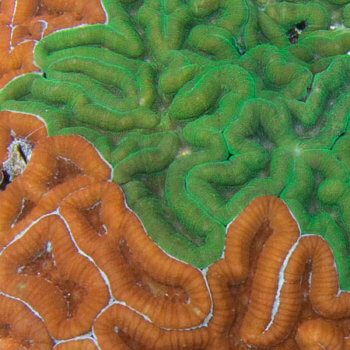
Palau Trip Report, April 2022
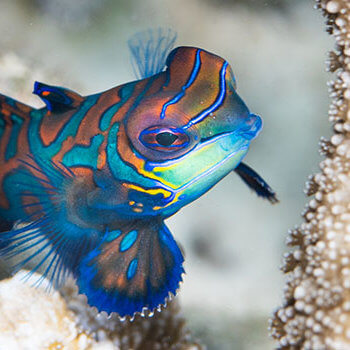
Palau 2019 Trip Report
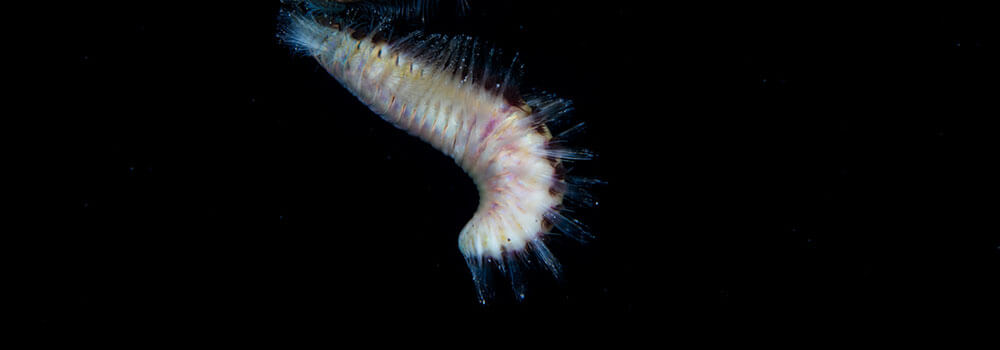
The Worms Came Out at Night in Palau

Butterflyfishes of Palau
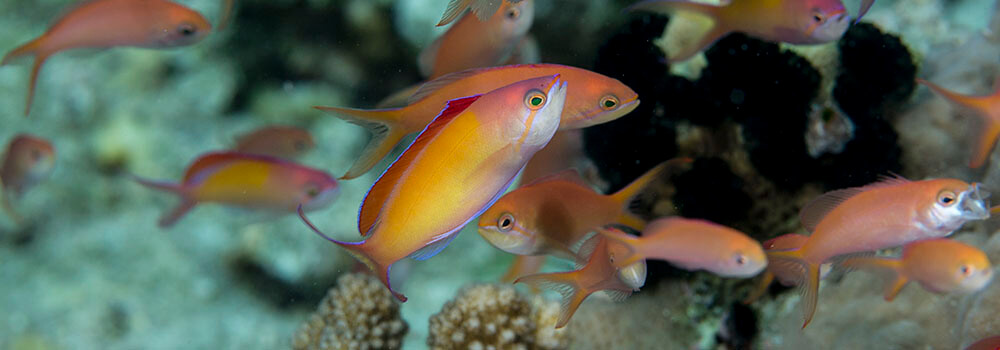
Palau Trip Report
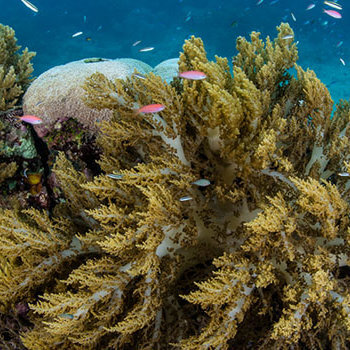
Papua New Guinea trip report 2019

Fish Galore in Alor!
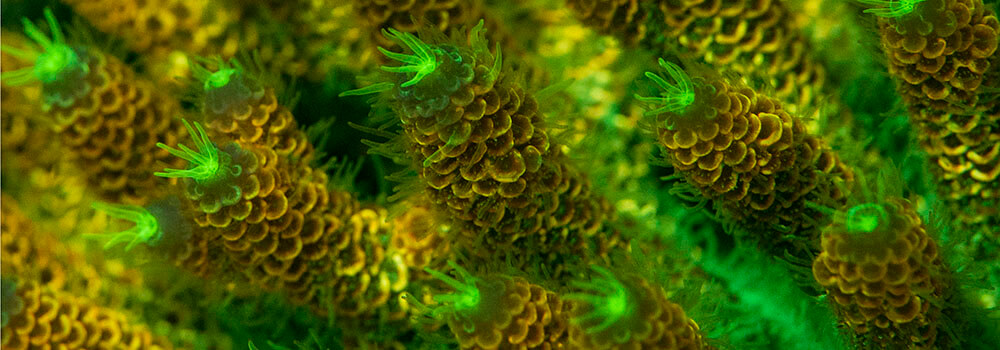
Underwater fluorescence, part 1

Another sea snake mimic?


